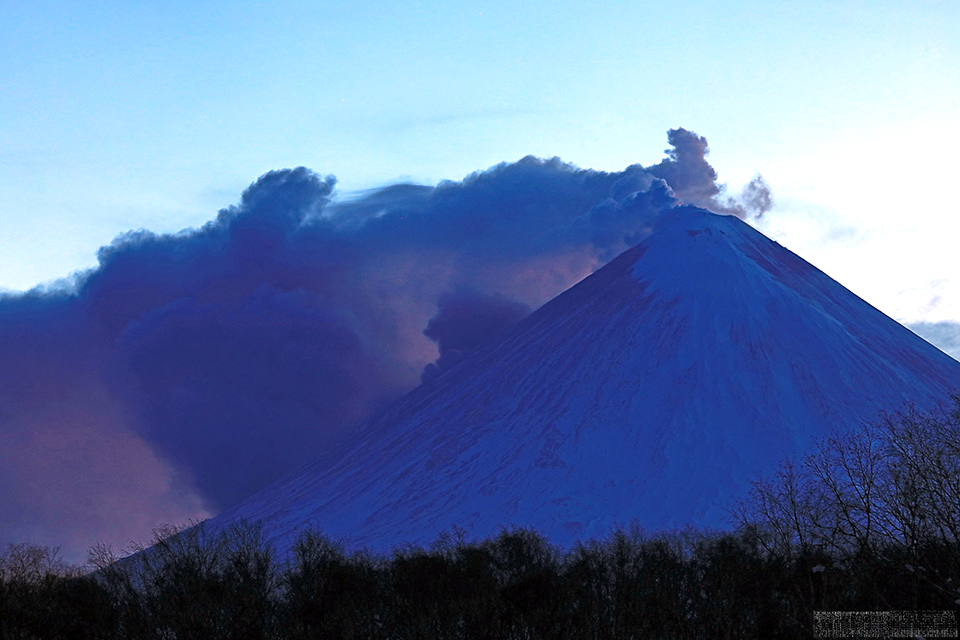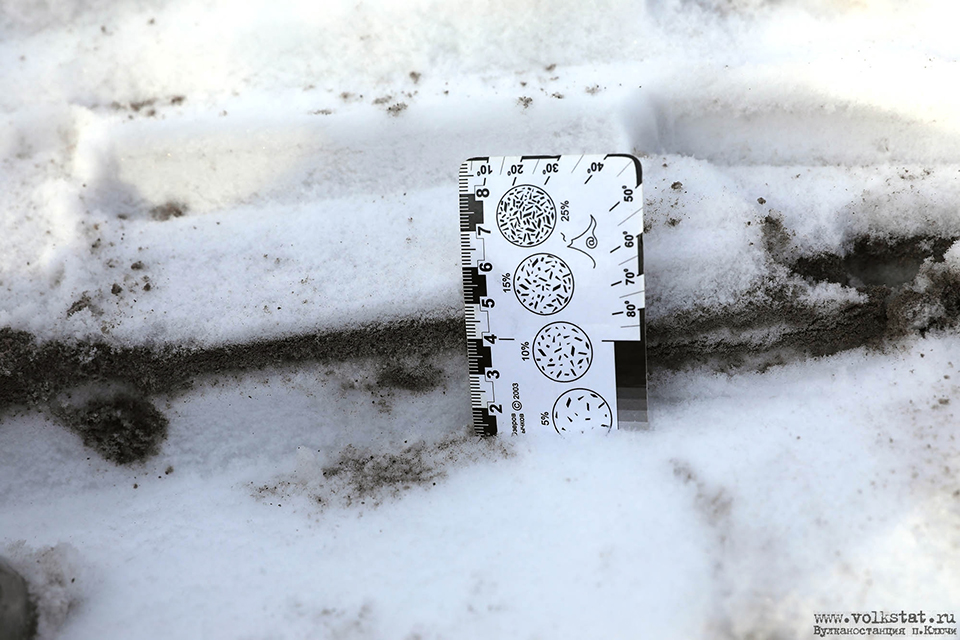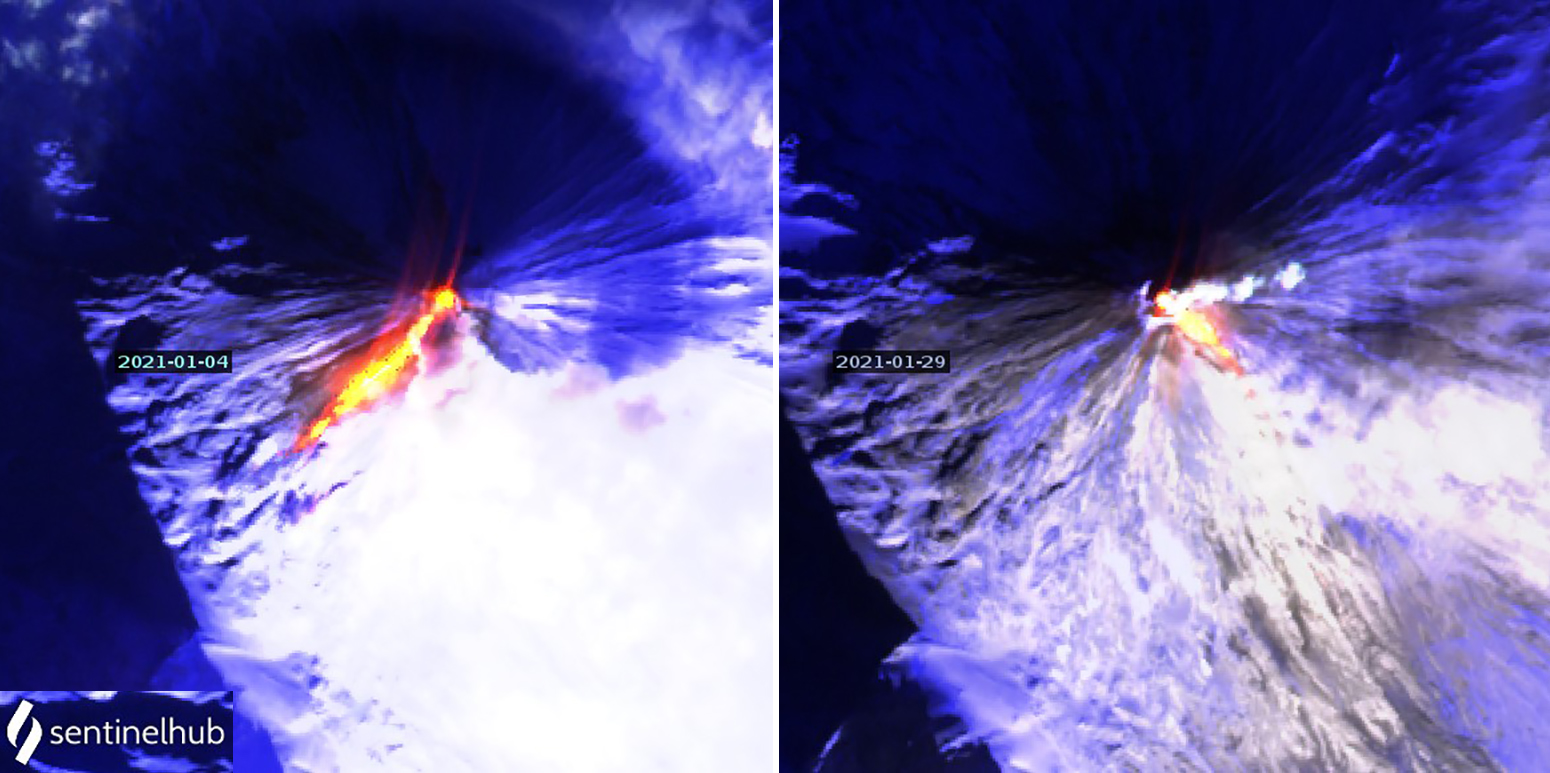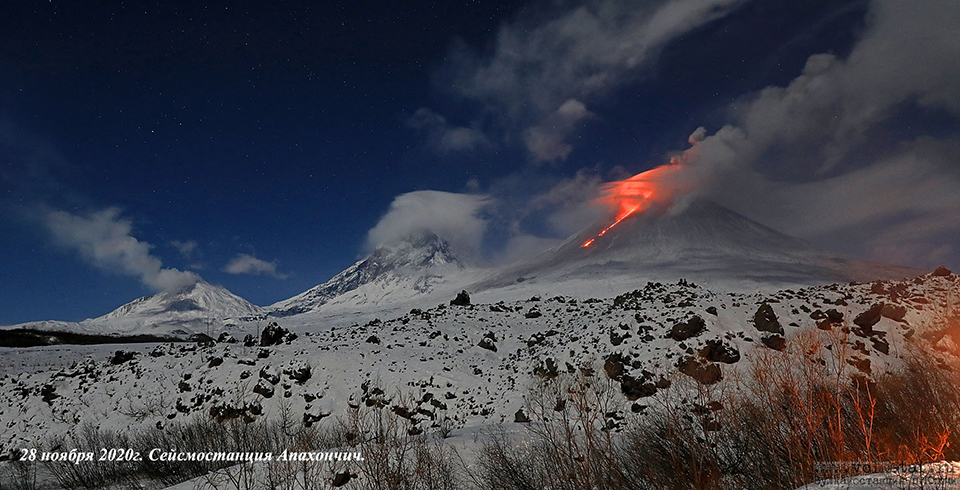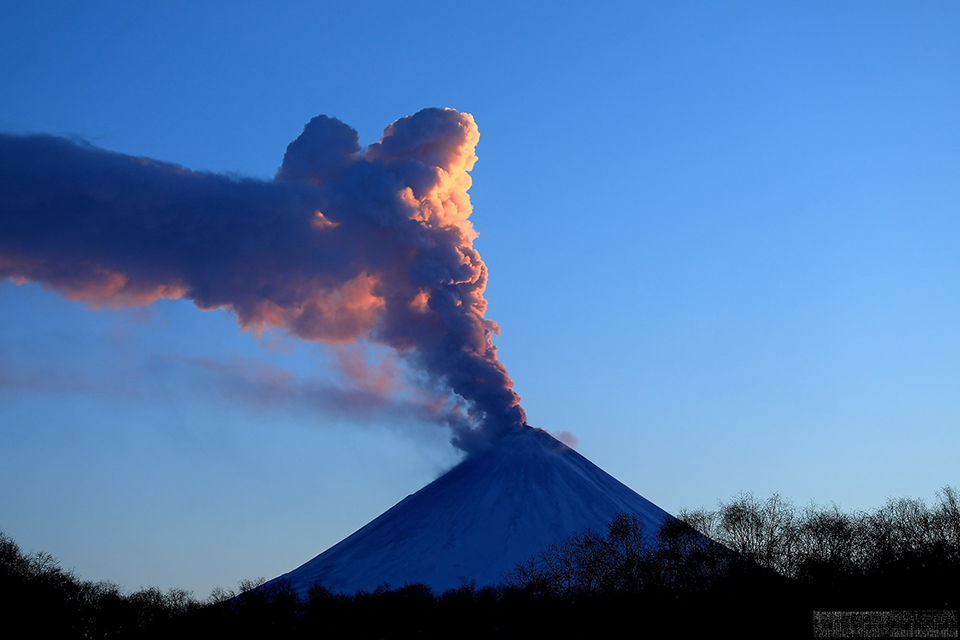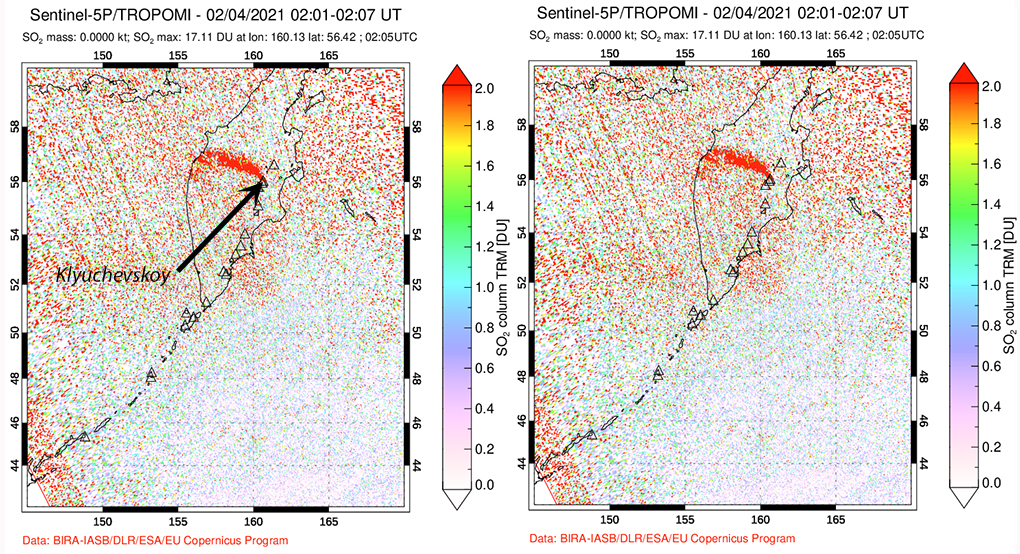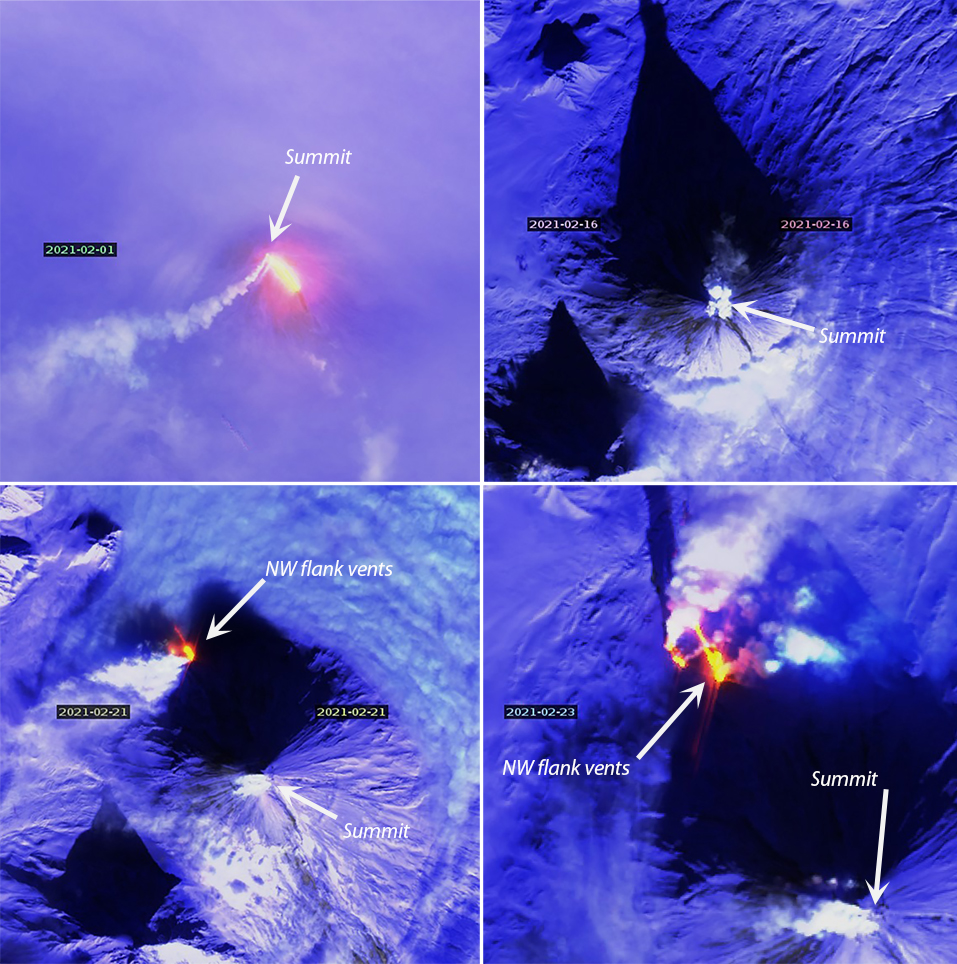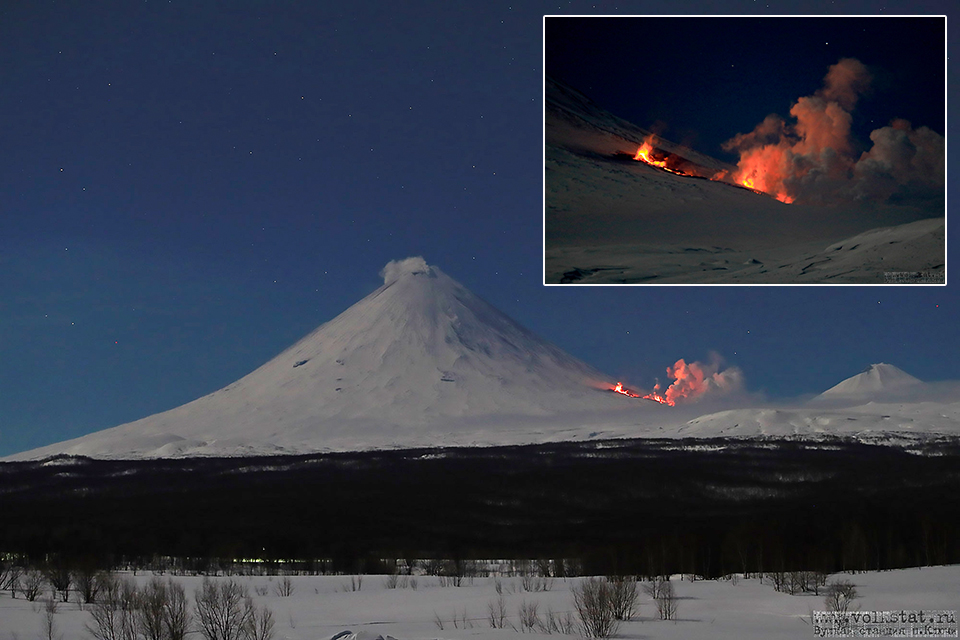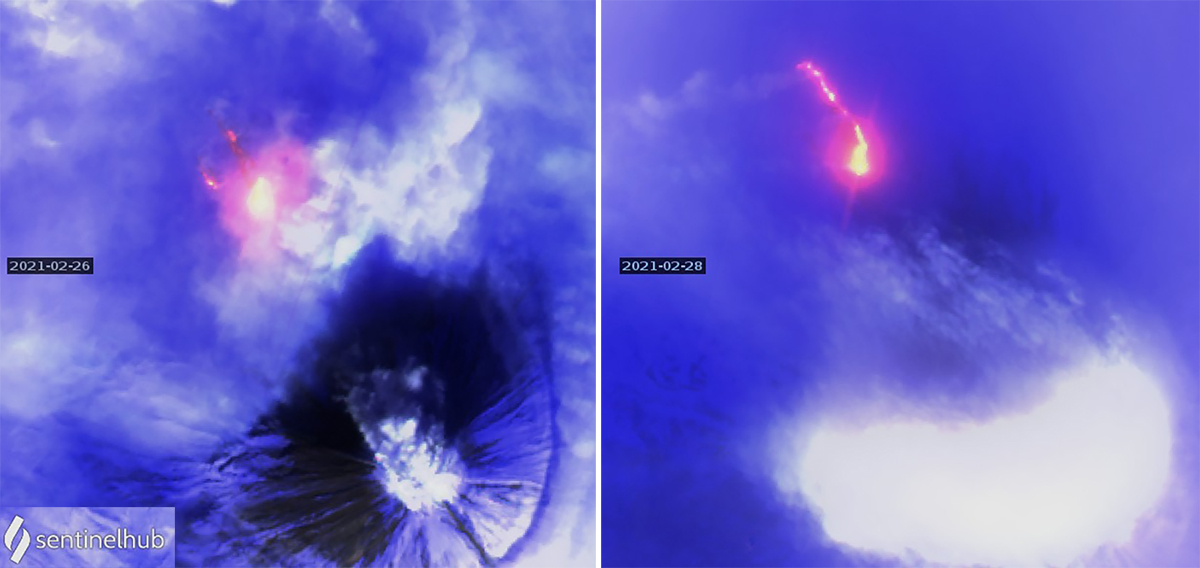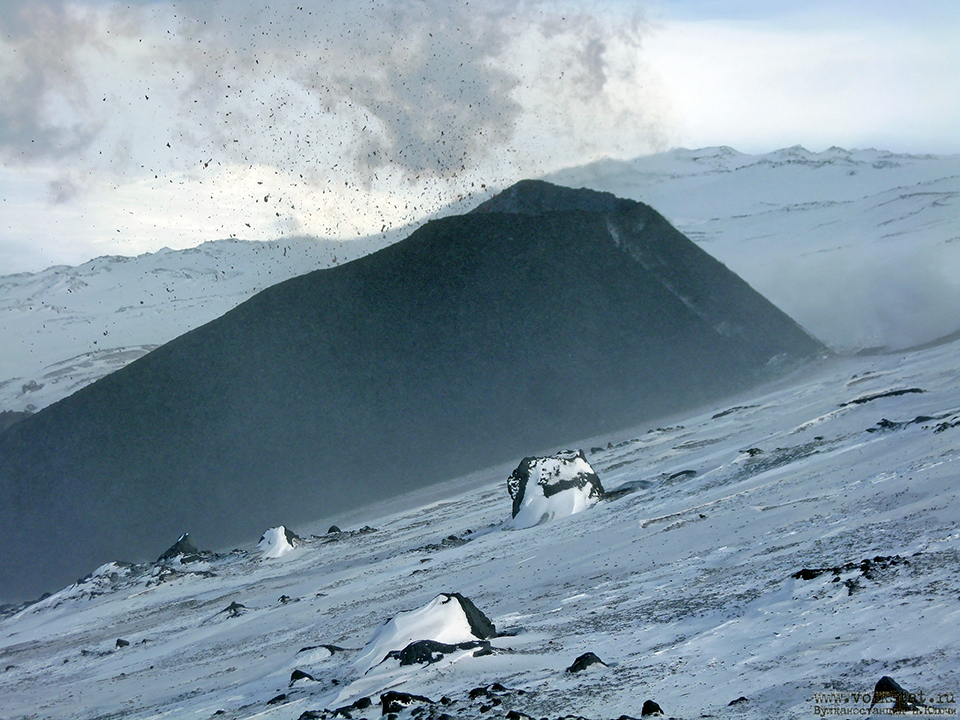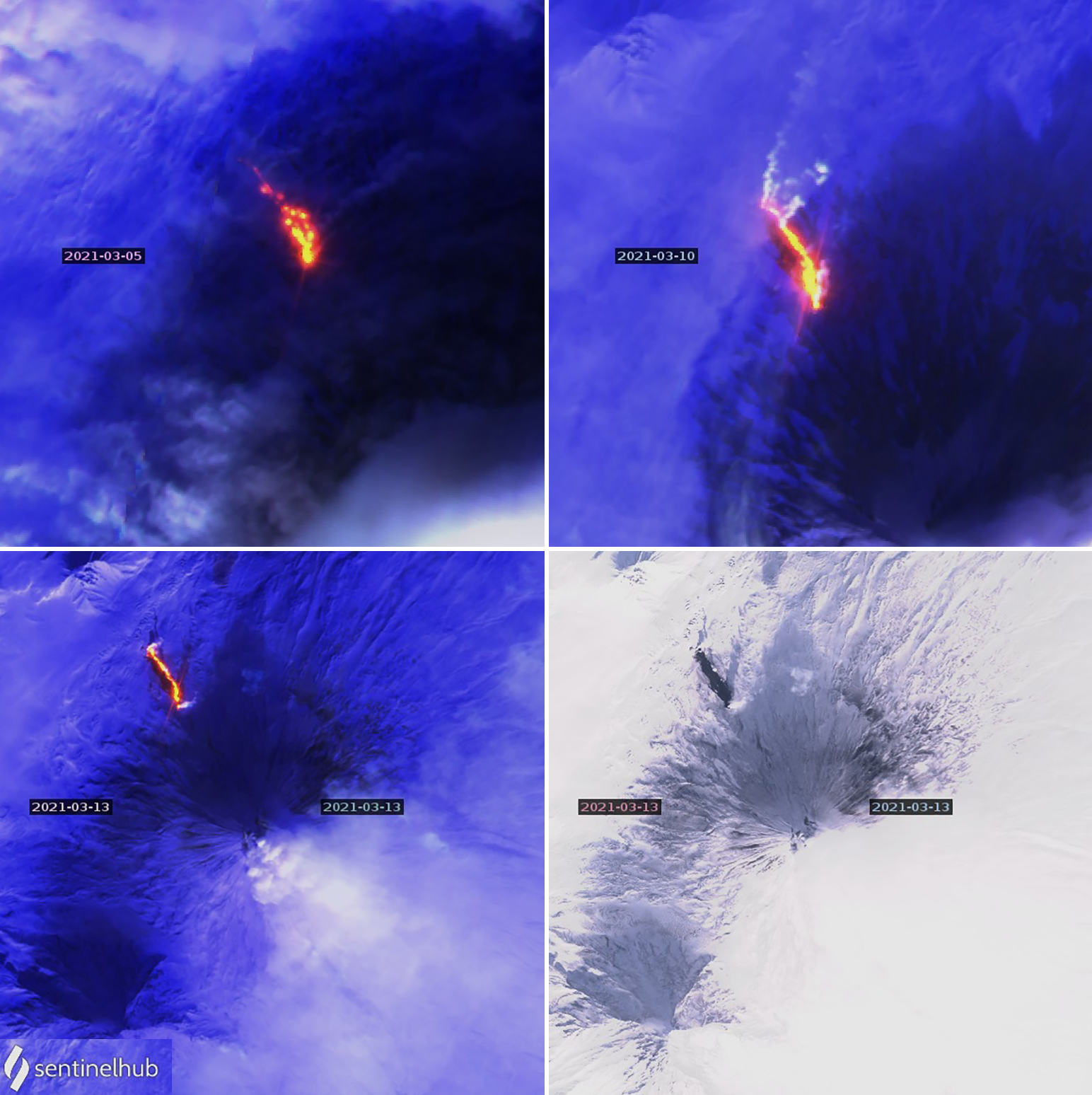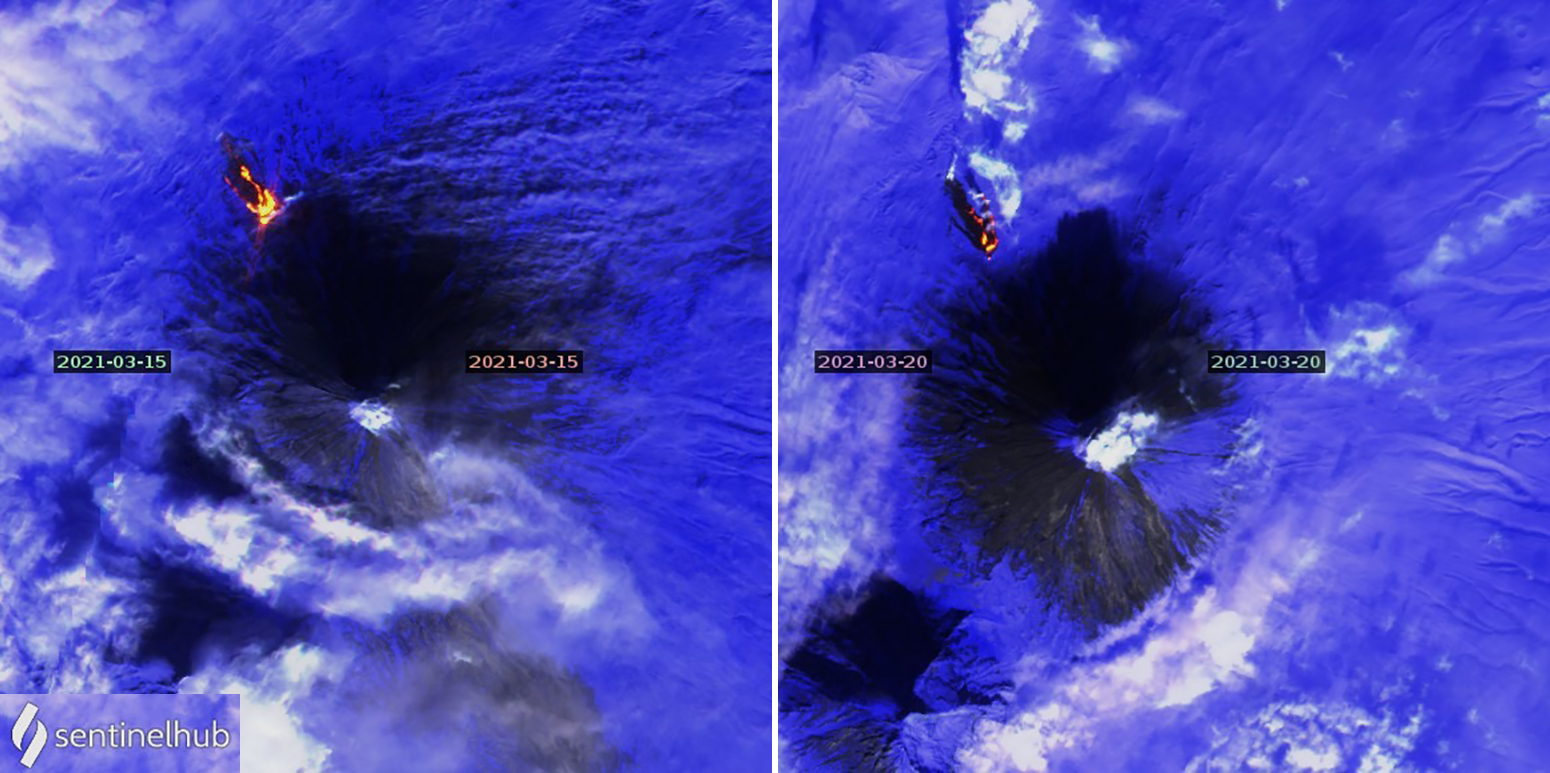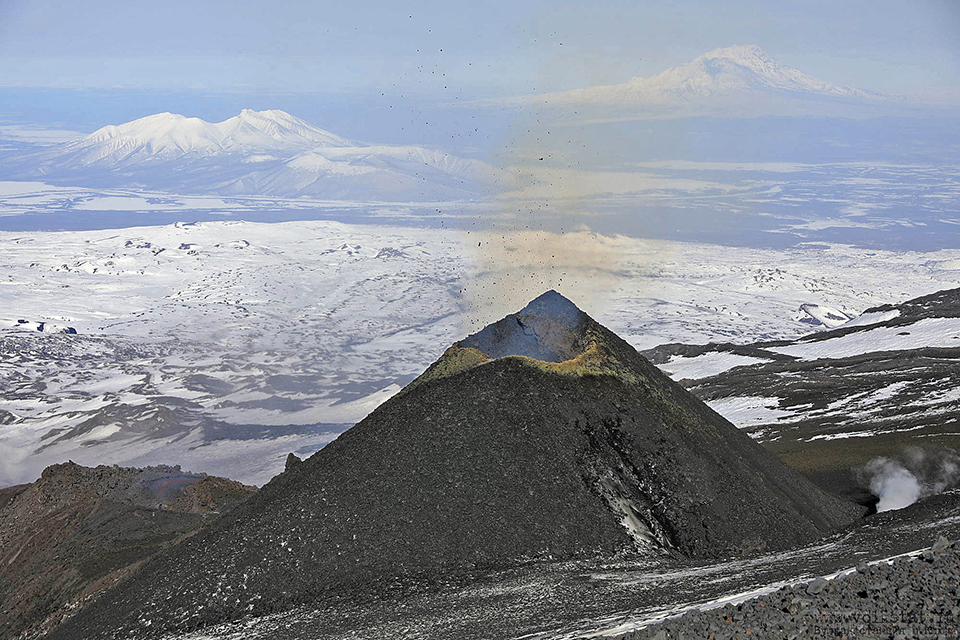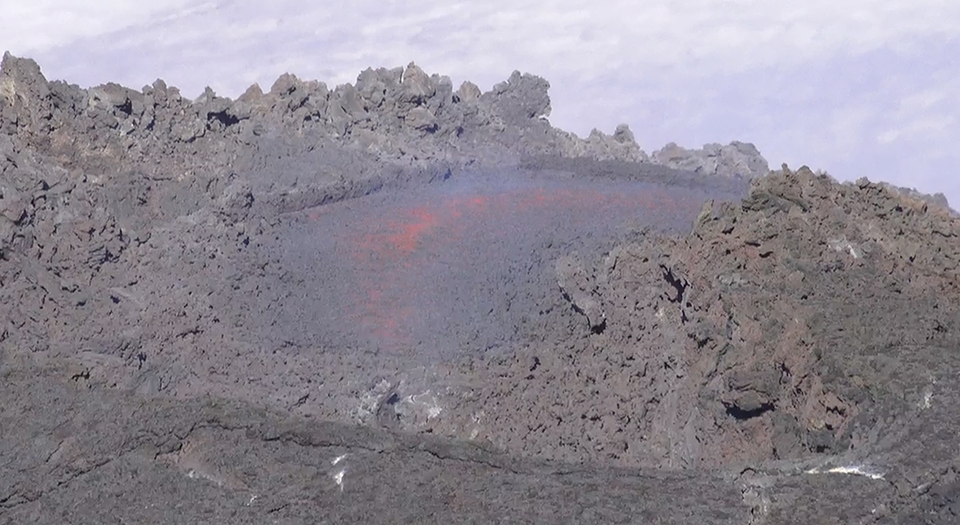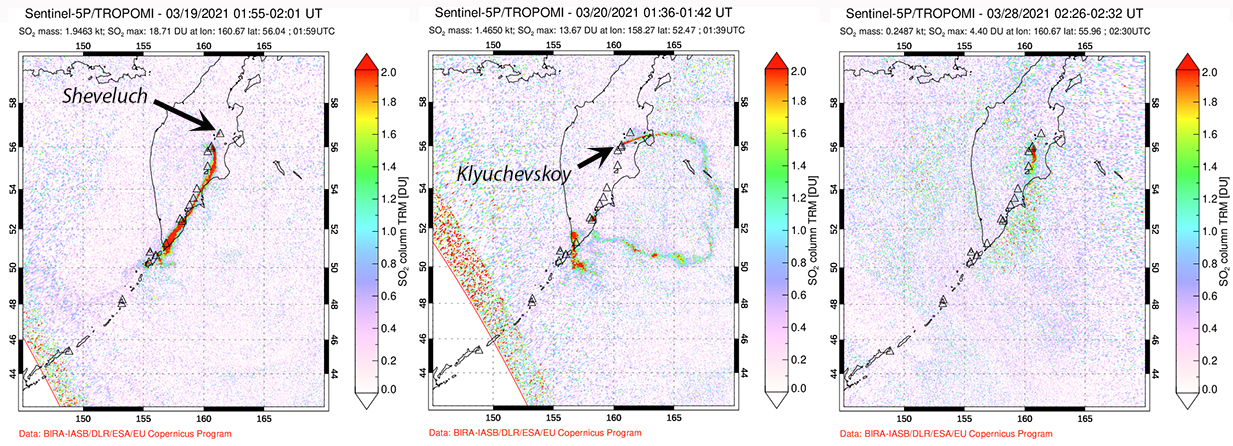Report on Klyuchevskoy (Russia) — April 2021
Bulletin of the Global Volcanism Network, vol. 46, no. 4 (April 2021)
Managing Editor: Edward Venzke.
Edited by A. Elizabeth Crafford.
Klyuchevskoy (Russia) Ash emissions and lava flows during January-February, new NW-flank vent and flow February-March 2021
Please cite this report as:
Global Volcanism Program, 2021. Report on Klyuchevskoy (Russia) (Crafford, A.E., and Venzke, E., eds.). Bulletin of the Global Volcanism Network, 46:4. Smithsonian Institution. https://doi.org/10.5479/si.GVP.BGVN202104-300260
Klyuchevskoy
Russia
56.056°N, 160.642°E; summit elev. 4754 m
All times are local (unless otherwise noted)
Klyuchevskoy, Kamchatka’s tallest volcano, has had over 100 recorded historical eruptions during the last 300 years characterized by major explosive and effusive events from summit and flank craters. Activity since April 2019 has consisted of ash plumes, Strombolian activity, and active lava flows on multiple flanks. Renewed Strombolian activity and lava flows began in October 2020 and continued into 2021, ending in late March. January-March 2021 is covered in this report with information provided by the Kamchatkan Volcanic Eruption Response Team (KVERT), the Kamchatka Volcanological Station, the Tokyo Volcanic Ash Advisory (VAAC), and satellite data.
Renewed explosive and effusive activity that began in October 2020 (BGVN 46:01) continued into 2021. A lava flow was active in the Kozyrevsky chute on the SW flank through mid-January; a flow again entered the SE-flank Apakhonchi chute in late January. Flow activity and Strombolian explosions from the summit ended in early February. A new vent near the base of the NW flank opened up on 17 February, sending a lava flow N and NW until the third week of March. Steam and gas emissions continued at the summit through the end of March. Explosive activity was very high during January 2021 with one or more ash explosions almost every day; significant ashfall occurred in mid-January. After a significant explosion in early February, subsequent ash plumes were all caused by resuspended ash from earlier events.
The MIROVA thermal anomaly graph for Klyuchevskoy closely follows the activity witnessed on the ground and seen in satellite images. The reappearance of very high levels of Radiative Power in early October 2020 coincided with the effusion of lava flows that remained active until early February 2021. A pulse of thermal energy that began in mid-February corresponded to the new vent on the NW flank about 5 km from the summit (figure 55). Activity stopped at the new vent in mid-March, but low levels of thermal energy remained from the cooling flows and from steam and gas emissions at the summit. MODVOLC thermal alert data included near-daily alerts from 1 January through 3 February. A second pulse of alerts was recorded from 20 February-19 March 2021.
The Tokyo VAAC reported an ash plume that rose to 7.6 km altitude and drifted SE on 1 January 2021. Two explosions the next day produced ash plumes that drifted SE at 6.1 km altitude. The Kamchatka Volcanological Station reported a landslide in the Apakhonchi chute on the SE flank on 2 January that generated an ash cloud which rose 1 km above the slope and drifted SE (figure 56). One or two daily explosions were reported through 7 January, generating ash plumes that rose to 6.1-7 km altitude and drifted in multiple different directions. KVERT reported ash plumes drifting as far as 70 km the first week and 90 km the second week of the month along with Strombolian and some Vulcanian activity (figure 57). Multiple explosions during 12-17 January produced ash that drifted NE or E at 6.1-7 km altitude, sometimes reaching 200 km from the volcano.
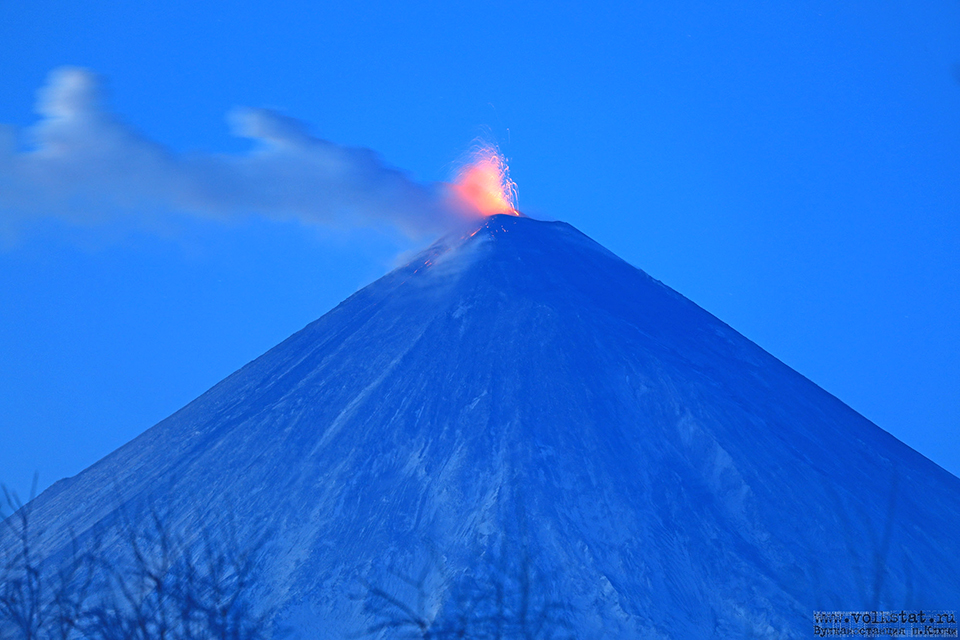 |
Figure 57. Strombolian activity sent ejecta tens of meters above the summit of Klyuchevskoy on 14 January 2021. Photo by Y. Demyanchuk, courtesy of Kamchatka Volcanological Station. |
A strong explosion on 18 January 2021 sent ash to 7.5 km altitude that drifted 500 km W. Two hours after the explosion ashfall began in Kozyrevsk village 50 km W. After a large snowstorm the next day 1 cm of ash was measured under 50 cm of fresh snow (figure 58). During 20-23 January ash plumes rose to 6.1-7.6 km altitude and drifted SW and NE. A large explosion on 24 January produced ash that initially rose to 8.5 km altitude and drifted W. Ash was later reported extending W at 10.4 km altitude and remained visible in satellite imagery into the next day, drifting 60 km N then NE. The explosion resulted in the collapse of areas along the edge of the Apakhonchi chute and produced multiple ash avalanches that descended 1,700 m from the summit in a few minutes (figure 59). During 28-31 January ash emissions rose to 3-6.1 km altitude and drifted NE and NW; KVERT reported an ash plume extending 92 km E on 29 January.
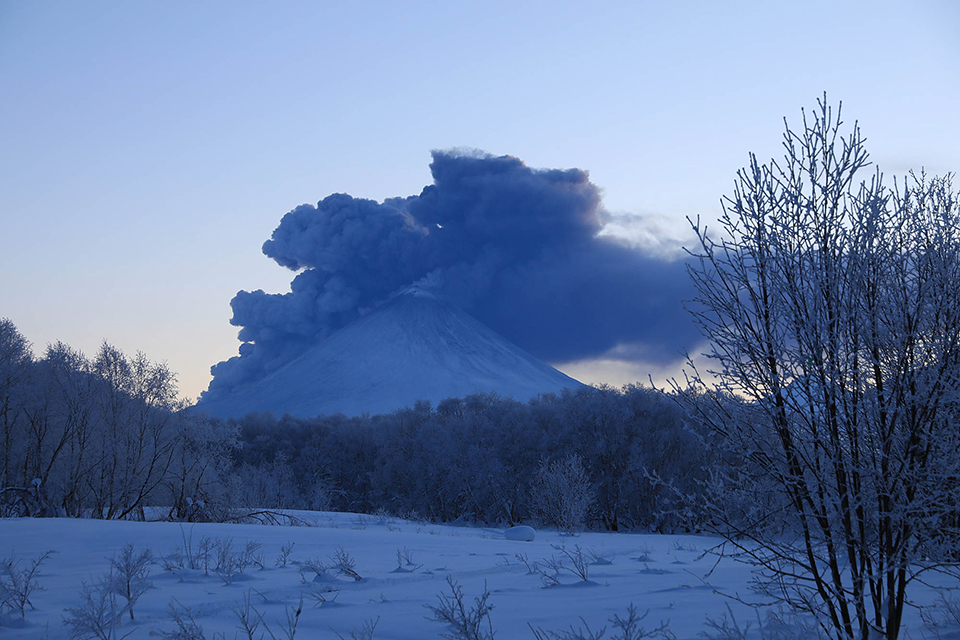 |
Figure 59. Ash plumes descended the SE flank of Klyuchevskoy on 24 January 2021 from a collapse of the summit crater rim. Photo by Y. Demyanchuk, courtesy of Kamchatka Volcanological Station. |
At the beginning of January 2021, the lava flow in the Kozyrevsky chute on the SW flank that first appeared in images on 10 December 2020 remained active; it was visible in Sentinel 2 satellite imagery on 2, 4, and 7 January (figure 60). In the 14 and 17 January images it was about half as long as it had been previously. In a 22 January image a second flow in the Apakhonchi chute on the SE flank was partly visible under clouds, with a short flow remaining in the SW Kozyrevsky chute. KVERT first reported activity in the Apakhonchi chute on 21 January; satellite imagery on 24, 27, and 29 January and a photo from 28 January confirmed that it remained active while the flow in the Kozyrevsky chute had cooled (figure 61).
There were far fewer ash emissions during February than January 2021. The Tokyo VAAC reported ash plumes on 2 and 3 February that rose to 5-6.1 km altitude and drifted E, NE, and W. An explosion on 4 February sent an ash plume ESE at 7 km altitude. Two large explosions on 5 February sent ash plumes that drifted ENE to 8.2 and 9.1 km altitude (figure 62). Continuous emissions that drifted W at 6.1 km altitude were noted on 7 February; KVERT reported satellite imagery of ash drifting 200 km W that day. KVERT issued a VONA reporting a significant decrease in seismicity overnight on 7-8 February. According to the seismological service, the volcanic tremor signal dropped to values less than 1 μm/s. The Kamchatka Volcanological Station reported that effusive activity stopped overnight during 8-9 February, and KVERT considered the summit eruption over. A small cinder cone had grown in the SE part of the summit crater during the eruption. During 12-14 February the Tokyo VAAC reported resuspended ash from the flanks at 4.6-5.2 km altitude. Sulfur dioxide emissions are difficult to detect in satellite instruments at high latitudes in winter. In spite of this, distinct SO2 plumes were recorded on 4 and 15 February drifting away from the volcano (figure 63).
The lava flow on the SE flank was active in the Apakhonchi chute during the first week of February 2021, visible in satellite imagery on 1, 3, and 6 February. After that there was no sign of thermal activity at the summit or either the SW or SE chutes on 13 or 16 February. KVERT reported in a VONA on 17 February that a lateral vent on the NW flank began to open around 1130 UTC at an elevation of about 2,800 m near the Erman glacier. Snowfall during 17-19 February prevented video observation, but bright incandescence that appeared on 20 February suggested lava was flowing from the vent. Satellite imagery on 21 February confirmed incandescence and lava flows at two vents on the NW flank; they continued to grow and were both visible in images on 23 February (figure 64).
The lava flows on the NW flank melted parts of the Erman glacier and produced a lahar that was reported on 23 February 2021 traveling down the Krutenkaya River about 7 km from the village of Klyuchi. Strombolian ejecta sent bombs 50 m from the vents on 25 February and a small cinder cone had formed at the upper vent (figure 65). Satellite images showed two flows on 26 February but only one was active on 28 February (figure 66).
An ash plume was reported by the Tokyo VAAC drifting E at 4.9 km altitude on 5 March 2021. KVERT noted that the ash was resuspended from material on the E flank and extended 375 km E of the volcano. KVERT reported that the lava flow on the NW flank remained active for the first two weeks of March 2021 with Strombolian activity at the cinder cone at the head of the flow. On 2 March a group of volcanologists from the IVS FEB RAS visited the site of the cinder cone and flow on the NW flank. The cone measured about 54 m high and 101 m wide at the base (figure 67). The lava flowed NW, penetrating into the Erman glacier, causing melting and mudflows in the Krutenkaya River (figure 68).
The Kamchatka Volcano Station reported on 14 March 2021 that the flow rate had decreased, and the lava was flowing N (figure 69). A field survey from the Station noted a decrease in activity at the NW-flank vent, now referred to as the Gorshkov vent, on 16 March (figure 70). They reported that only a small flow emerged from the W foot of the cone and flowed N (figure 71). Incandescent ejecta rose about 100 m above the cinder cone every few seconds. KVERT reported that the NW flank activity had stopped by 22 March. Weak incandescence was still observed over the cinder cone and lava flows in video images, but the intensity had decreased significantly. During the last week of March strong winds were responsible for plumes of resuspended ash from loose material on the SE flank near the Apakhonchi chute. On 25 March ash was visible in satellite imagery drifting E at 5.2-5.5 km altitude. KVERT reported it visible 72 km E from the volcano. Gas and steam emissions from the summit crater continued through the end of March (figure 72).
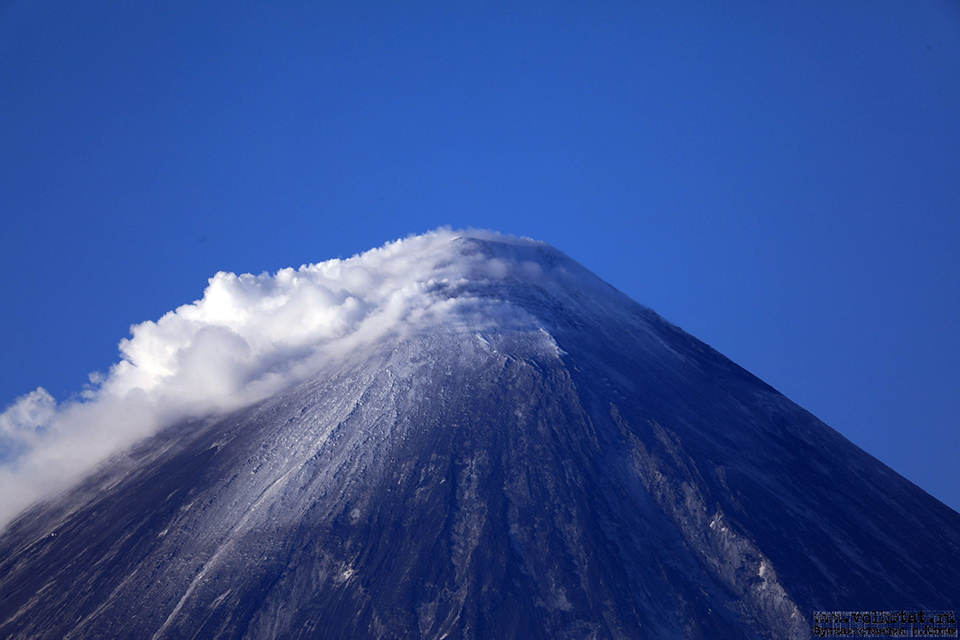 |
Figure 72. Gas and steam emissions from the summit crater of Klyuchevskoy are seen here on 24 March 2021. Photo by Y. Demyanchuk, courtesy of Kamchatka Volcanological Station. |
A large plume of SO2 drifted SW from Klyuchevskoy on 19 March 2021 and was still present the next day drifting E (figure 73). Multiple days of smaller but distinct SO2 emissions were detected during February and March 2021.
Geological Summary. Klyuchevskoy is the highest and most active volcano on the Kamchatka Peninsula. Since its origin about 6,000 years ago, this symmetrical, basaltic stratovolcano has produced frequent moderate-volume explosive and effusive eruptions without major periods of inactivity. It rises above a saddle NE of Kamen volcano and lies SE of the broad Ushkovsky massif. More than 100 flank eruptions have occurred during approximately the past 3,000 years, with most lateral craters and cones occurring along radial fissures between the unconfined NE-to-SE flanks of the conical volcano between 500 and 3,600 m elevation. Eruptions recorded since the late 17th century have resulted in frequent changes to the morphology of the 700-m-wide summit crater. These eruptions over the past 400 years have originated primarily from the summit crater, but have also included numerous major explosive and effusive eruptions from flank craters.
Information Contacts: Kamchatka Volcanic Eruptions Response Team (KVERT), Far Eastern Branch, Russian Academy of Sciences, 9 Piip Blvd., Petropavlovsk-Kamchatsky, 683006, Russia (URL: http://www.kscnet.ru/ivs/kvert/); Kamchatka Volcanological Station, Klyuchi, Kamchatka Krai, Russia (URL: http://volkstat.ru/); MIROVA (Middle InfraRed Observation of Volcanic Activity), a collaborative project between the Universities of Turin and Florence (Italy) supported by the Centre for Volcanic Risk of the Italian Civil Protection Department (URL: http://www.mirovaweb.it/); Hawai'i Institute of Geophysics and Planetology (HIGP) - MODVOLC Thermal Alerts System, School of Ocean and Earth Science and Technology (SOEST), Univ. of Hawai'i, 2525 Correa Road, Honolulu, HI 96822, USA (URL: http://modis.higp.hawaii.edu/); Tokyo Volcanic Ash Advisory Center (VAAC), 1-3-4 Otemachi, Chiyoda-ku, Tokyo 100-8122, Japan (URL: http://ds.data.jma.go.jp/svd/vaac/data/); Sentinel Hub Playground (URL: https://www.sentinel-hub.com/explore/sentinel-playground); NASA Global Sulfur Dioxide Monitoring Page, Atmospheric Chemistry and Dynamics Laboratory, NASA Goddard Space Flight Center (NASA/GSFC), 8800 Greenbelt Road, Goddard, Maryland, USA (URL: https://so2.gsfc.nasa.gov/).



